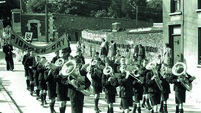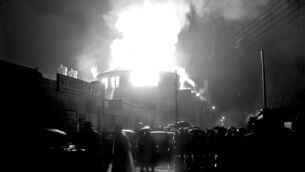Throwback Thursday: Memories of a show jumping legend and.. fun with first ever car
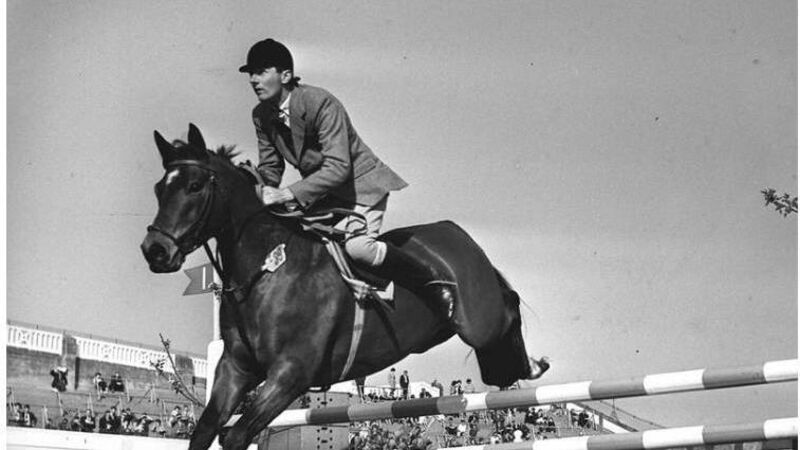
Tommy Wade on Dundrum.
OUR feature in Throwback Thursday last week on the old Cork Summer Show at the Marina showgrounds evoked an instant response from Eileen Barry.
“Oh that was the day of the year for us! I do remember that we had to get a day off school, because it was held during the week. My best friend and I were at Miss Cahill’s primary school and my older sister persuaded her to let us off because the show would be so educational for us. And it worked!!”
Yes, it’s worth noting that the old show was always held on weekdays not at the weekend as all modern ones are. (Back then the focus was on exhibitors and agriculturalists, not on holidaymakers.)
Three things Eileen remembers in particular: “First, the leaflets and brochures. From every stall and stand at the show. I think we counted at the end of the day to see who had the most... About cattle, sheep, animal feeds, animal health, tractors, trailers, machinery. Everything! The people manning the stands must have hated giving away so many leaflets to kids who obviously had little or no interest in agriculture! We would carry them round the entire day, to bring home proudly.”
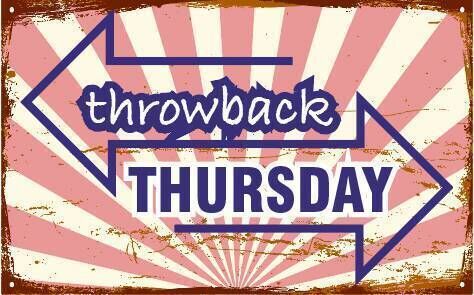
Secondly, recalls Eileen, the vegetable exhibition, and the Arts and Crafts exhibition. “The veg were amazing: massive leeks, potatoes carrots etc, all beautifully displayed, with winning rosettes on the favoured few. I think this was also the section where the ‘Miniature Garden’ entries were. We occasionally entered in this class; pinching a roasting tray from the kitchen, filling it with earth and growing the smallest plants we could find. Tiny flat stones for footpaths, little houses or sheds made of matchsticks. A piece of mirror for a pond. I’m not sure if we ever won anything, but we always tried. There was a magic to making a miniature garden that we never tired of!
“Then there was the Arts and Crafts section. The sheer range of quilts, knits, crochet, paintings, woodcarving – it was marvellous to see so many different skills at their very best. It’s sad you don’t see them so much any more.”
We agree, Eileen. Why, oh why, are crafts not taught in schools these days? Proper craftwork, that is, not joining up easy pieces from a shop-bought kit? All the skills needed for later years when a fence needs mending, a chair repairing, sheets patched, socks darned? They still have these intrinsic skills in Eastern Europe, but we seem to have ditched them in favour of a throwaway society.
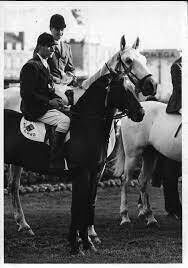
But the last part was the best of all, says Eileen.
“The showjumping! We’d be waiting at the gate to be the first to get in when the event was announced. Up into the stand so we could get a good view. It was really exciting, especially when the announcement was made, ‘and now Tommy Wade on Dundrum! That got the loudest applause. My memory of Dundrum was that he was quite a tidy, small grey horse, am I right? That really was a great finale to an exciting, memorable day out, and something to mull over in the coming months.”
Now there, Eileen, you touch on history. Dundrum, that incredible little Connemara cross, just over 15 hands high (about 5’), who could jump anything and had that wonderful skill of turning up his heels so that he never knocked a bar or a brick. He was – still is – a legend, as is his rider, the great Tommy Wade. Together they competed at the top levels of the sport from 1957 to 1967, again and again achieving the impossible, including clearing a 7-foot-plus Puissance wall at Wembley in the Horse of the Year show of 1961 against many of Europe’s top horses and riders.
TV broadcaster Frank Waters recorded that incredible moment.
“When Tommy and Dundrum entered the arena, the first to jump in that third round, you could have heard a pin drop. He cantered around the ring, over the big spread fence, and then all of us beyond the wall could not see him anymore, he was so small. It stood at more than seven feet two inches, may have been seven feet four.
“Suddenly there was a gasp from the crowd and we beyond the wall saw what was like a cat coming up over it. As they landed, Tommy looked back, saw they had cleared it and threw his hat in the air. Then the crowd of 18,000 were on their feet. I am amazed from the cheering and shouting that the roof stayed on!”
Most movingly, the other riders unanimously withdrew, and gave the trophy to little Dundrum, the horse with the heart of a lion. And didn’t he deserve it?
For Eileen and her friends, sitting in the grandstand at Cork, and listening to the deafening cheers that erupted as the pair entered the ring the following year, it was a memory never to be forgotten. Wade was inducted into the Showjumping Hall of Fame in 2013; Dundrum needs no such accolade to be remembered fondly forever by those lucky enough to see him in action so long ago.
Although horses (and cows and sheep and pigs and poultry) were a huge part of the Munster Agricultural Society’s annual show, motor vehicles were becoming a feature of the exhibits, with companies like Ford bringing down their latest models to be admired. Many a young man must have gazed and yearned, wondering how long it would be before they could ever afford their own first set of wheels.
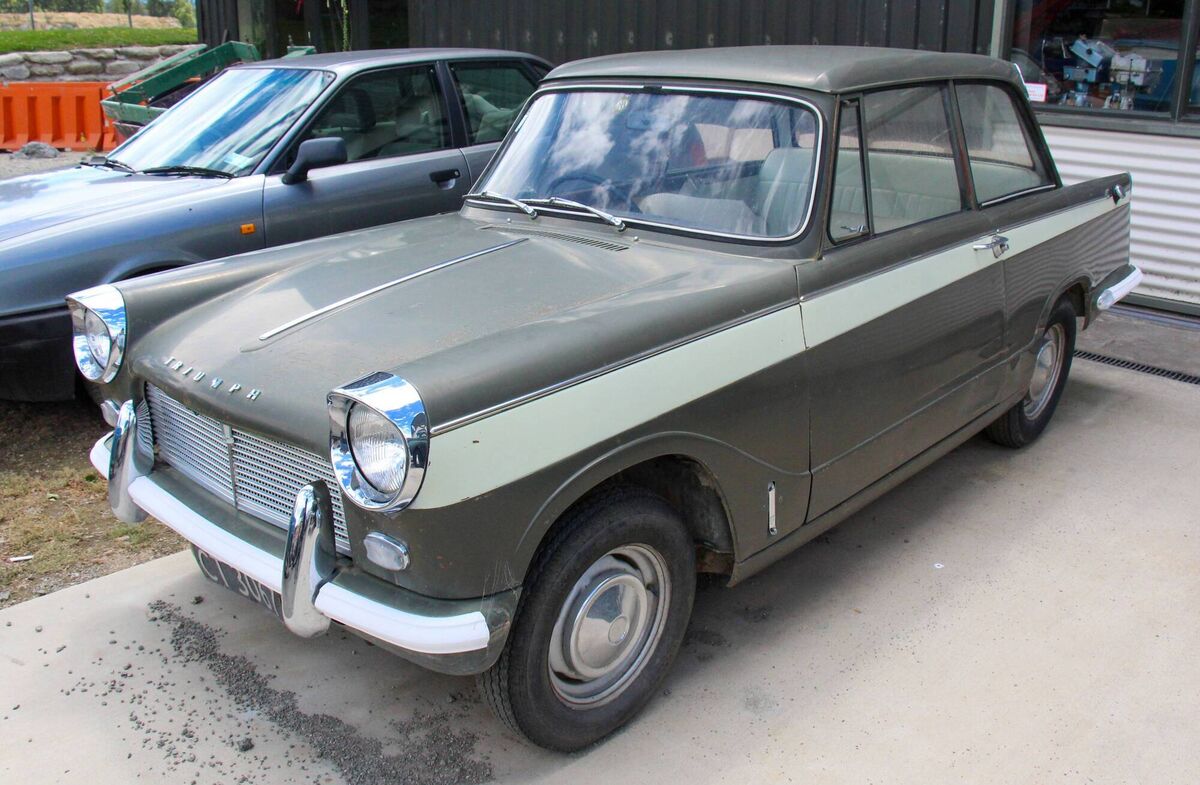
Tim Cagney asks: “Do you remember your first-ever car?”
He most certainly does.
“Mine was a ’63 Triumph Herald 1200,” says Tim. “My father never had a car of his own (the poor man devoted most of his modest earnings to educating myself and my younger brother) but in 1971 he decided that the household deserved one. I, at this stage, was a ‘working man’ and was designated the family driver. We - or rather he – bought it at the Eglantine Garage, in Douglas. Up to then, I had suffered for about a year on a motorcycle, getting many wettings in the all-too-frequent Cork rain. I used to envy people driving around in shirtsleeves, blissfully dry (and warm) in their 4-wheeled carriages – now I was one of them!
“The car was two-tone – brown, with a cream stripe down the side (officially “Sand & Sable”). It had a wooden dashboard and carpet. The bonnet and front wings were all one unit – the entire arrangement tipped forward, giving unfettered access to the engine. One feature I particularly enjoyed was a reserve-tank – in case you accidentally ran-out of petrol, you simple tweaked a lever on the fuel-tank, which gave you another half-gallon or so, to get you to the nearest filling-station. This was extremely useful, as my car had a dodgy fuel-gauge.
“One of the first things I did was take it for a drive in the country, where I aimed it at every puddle I could find. Unfortunately, I didn’t know that – under the carpet – lurked two holes, through which entered water, forming pools in both driver and passenger footwells. Rust was a major feature of second-hand cars in those days, with Triumph being especially notorious in said field. This, of course, was to lead me into the wonderful world of ‘David’s Isopon.’ You got a kit, which consisted of sheets of glass-fibre. You soaked these in resin, the vapours from which would render a horse unconscious. The application was placed over an offending hole in the bodywork, and allowed to set. Then the fibreglass was coated with a paste, which would harden. After that, you had to smoothen the result with sandpaper. Then followed a trip to an accessory-shop, where you acquired a ‘rattle-can’ of the appropriate paint-colour, and sprayed it on. Unfortunately, colour-matching – back then – was not an exact science, and the paint-colour in the cans seldom matched the original colour of the car. Thus, you ran the risk of having a vehicle of many colours, depending on how much patching you had done.
“Needless to say, an eight-year-old car needed quite a bit of maintenance. This led me to the discovery of a scrapyard on the Clash Road, near Little Island. This, essentially, consisted of a field, in which scores of crashed cars – of every make and variety – would be piled on top of one another. It was up to the customer to remove whatever might be needed from the collection in the field and pay the owner on the way out. Said owner was a gent by the name of Higgins. He amused himself by rotating a pair of shotgun-cartridges in one hand, much like the character portrayed by Humphrey Bogart in The African Queen, who habitually played with a pair of steel balls. I got the impression that this was to discourage light-fingered individuals, who might be prone to skipping out of the compound with bits and bobs concealed upon their persons.
“The charges were modest, and I visited the place regularly, supplementing my ageing car’s endless needs. One of these was a speedometer-clock, the reason being that my high-beam indicator light was red, and I wanted a blue one. Another advantage of this, of course, was that the replacement clock had a lower mileage-reading than the original! Another problem was the fact that my fuel-gauge didn’t work properly – it only showed half-full when it was (in fact) totally full. I discovered that the relevant mechanism was operated by a float in the fuel-tank, much like the ballcock in your average toilet-cistern. A working replacement was soon acquired from the scrapyard, and duly fitted. However, I obviously got the polarity wrong, as the gauge now read full when the tank was empty and empty when full.”
Tim’s most amusing memory of Mr. Higgins’s field was the day he decided to fit reversing-lights to his Triumph.
“Such things were quite innovative, at the time, and I was keen to get in on the act. My plan was to acquire a pair of parking-lights, which I would then screw to the rear bodywork. A length of wiring would then run under the carpet to the electrical system, via a toggle-switch fitted on the dash. I found an unusually large set of such lights on one of the cars in the yard – something of a rarity, called a Borgward Isabella. I started unscrewing the lamps, but suddenly I heard a shout – ‘Hey, that’s my car. It’s not for scrapping – it’s only in for a service!’
It seems that Mr. Higgins was not only the custodian of a car graveyard but also offered his expertise as a mechanic – apparently, he was renowned for his knowledge of the brand known as “NSU”. Someone later told me that he had a standard charge of £2.00, irrespective of the nature of the service.”
Tim still remembers the registration number of my first automotive “love” – HPI 37.
“These days, I drive a Germanic vehicle. It has a 2-litre diesel engine, with an 8-speed automatic gearbox. It has programmed seats, which can adjust themselves to suit the driving positions of myself and “She-Who-Shares-My-Life”. It has a plethora of gadgets, most of which I’m blissfully unaware of. Can I remember the registration? Of course not!”
Do you remember your first car? Or indeed that gallant little Connemara, Dundrum, who won all hearts at the Summer Show? Tell us your own memories. Email jokerrigan1@gmail.com. Or leave a comment on our Facebook page: https://www.facebook.com/echolivecork.

